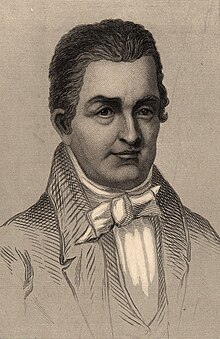Our website is made possible by displaying online advertisements to our visitors.
Please consider supporting us by disabling your ad blocker.
Oliver Evans
Oliver Evans | |
|---|---|
 "Oliver Evans, the Watt of America" Original portrait caption | |
| Born | September 13, 1755 |
| Died | April 15, 1819 (aged 63) New York City, New York, USA |
| Nationality | American |
| Occupation(s) | Inventor, engineer |
| Spouses | Sarah Tomlinson
(m. 1783–1816)Hetty Ward (m. 1818–1819) |
| Children | 7 |
| Signature | |
 | |
Oliver Evans (September 13, 1755 – April 15, 1819) was an American inventor, engineer, and businessman born in rural Delaware and later rooted commercially in Philadelphia. He was one of the first Americans to build steam engines and an advocate of high-pressure steam (as opposed to low-pressure steam). A pioneer in the fields of automation, materials handling and steam power, Evans was one of the most prolific and influential inventors in the early years of the United States. He left behind a long series of accomplishments, most notably designing and building the first fully automated industrial process, the first high-pressure steam engine, first vapor compression refrigeration and the first (albeit crude) amphibious vehicle and American automobile.
Born in Newport, Delaware, Evans received little formal education and in his mid-teens was apprenticed to a wheelwright. Going into business with his brothers, he worked for over a decade designing, building and perfecting an automated mill with devices such as bucket chains and conveyor belts. In doing so Evans designed a continuous process of manufacturing that required no human labor. This novel concept would prove critical to the Industrial Revolution and the development of mass production. Later in life Evans turned his attention to steam power and built the first high-pressure steam engine in the United States in 1801, developing his design independently of Richard Trevithick, who built the first in the world a year earlier. Evans was a driving force in the development and adoption of high-pressure steam engines in the United States. Evans dreamed of building a steam-powered wagon and eventually constructing and running one in 1805. Known as the Oruktor Amphibolos, it was the first automobile in the country and the world's first amphibious vehicle, although it was too primitive to be a success as either.
Evans was a visionary who produced designs and ideas far ahead of their time. He was the first to describe vapor-compression refrigeration and propose a design for the first refrigerator in 1805, but it would be three decades until his colleague Jacob Perkins would be able to construct a working example. Similarly, he drew up designs for a solar boiler, machine gun, steam-carriage gearshift, dough-kneading machine, perpetual baking oven, marine salvage process, quadruple-effect evaporator, and a scheme for urban gas lighting, ideas and designs which would not be made reality until some time after his death. Evans had influential backers and political allies, but lacked social graces and was disliked by many of his peers. Disappointed and then angry at the perceived lack of recognition for his contributions, Evans became combative and bitter in later years, which damaged his reputation and left him isolated. Despite the importance of his work, his contributions were frequently overlooked (or attributed to others after his death) so he never became a household name alongside the other steam pioneers of his era.
Previous Page Next Page


